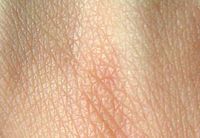
Photo from wikipedia
AIMS Specific fibroblast markers and in-depth heterogeneity analysis are currently lacking, hindering functional studies in cardiovascular diseases (CVD). Here, we established cell-type markers and heterogeneity in murine and human arteries… Click to show full abstract
AIMS Specific fibroblast markers and in-depth heterogeneity analysis are currently lacking, hindering functional studies in cardiovascular diseases (CVD). Here, we established cell-type markers and heterogeneity in murine and human arteries and studied the adventitial fibroblast response to CVD and its risk factors hypercholesterolemia and aging. METHODS & RESULTS Murine aorta scRNA-seq analysis of adventitial mesenchymal cells identified fibroblast-specific markers. Immunohistochemistry and flow cytometry validated platelet-derived growth factor receptor alpha (PDGFRA) and dipeptidase 1 (DPEP1) across human and murine aorta, carotid, and femoral arteries, while traditional markers such as cluster of differentiation (CD)90 and vimentin also marked transgelin + vascular smooth muscle cells. Next, pseudotime analysis showed multiple fibroblast clusters differentiating along trajectories. Three trajectories, marked by CD55 (Cd55+), Cxcl chemokine 14 (Cxcl14+) and lysyl oxidase (Lox+), were reproduced in an independent RNAseq dataset. Gene ontology analysis showed divergent functional profiles of the three trajectories, related to vascular development, antigen presentation and/or collagen fibril organization, respectively. Trajectory-specific genes included significantly more genes with known genome-wide associations (GWAS) to CVD than expected by chance, implying a role in CVD. Indeed, differential regulation of fibroblast clusters by CVD risk factors was shown in adventitia of aged C57BL/6J mice, and mildly hypercholesterolemic LDLR-KO mice on chow by flow cytometry. The expansion of collagen-related CXCL14 + and LOX + fibroblasts in aged and hypercholesterolemic aortic adventitia respectively, coincided with increased adventitial collagen. Immunohistochemistry, bulk, and single-cell transcriptomics of human carotid and aorta specimens emphasized translational value as CD55+, CXCL14 + and LOX + fibroblasts were observed in healthy and atherosclerotic specimens. Also, trajectory-specific gene sets differentially correlated to human atherosclerotic plaque traits. CONCLUSION We provide two adventitial fibroblast-specific markers, PDGFRA and DPEP1, and demonstrate fibroblast heterogeneity in health and cardiovascular disease in humans and mice. Biological relevance is evident from regulation of fibroblast clusters by age and hypercholesterolemia in vivo, associations with human atherosclerotic plaque traits, and enrichment of genes with a GWAS for CVD.
Journal Title: Cardiovascular research
Year Published: 2023
Link to full text (if available)
Share on Social Media: Sign Up to like & get
recommendations!